|
-By Tim McDonald. |
| Summary |
| A R33 GTS-t turbocharger
can be adapted to fit onto a FJ20et engine. The R33 turbo offers a more
modern and efficient
design, featuring a roller bearing centre. It is larger than the original item. Note that they also feature a ceramic exhaust wheel which most people recommend not to take about around 14 psi. I replaced the standard turbo
on my FJ20et in my Bluebird with one from a R33 Skyline. The starting point
was a mostly stock
The result is a much more
drivable car, notably:
It was quite a lot of work
and set me back around $450, but I am happy with the result and can recommend
the swap.
|
| Procedure |
| 1.
Unbolt the exhaust from the dump pipe and get it out of the way
2.
Remove original turbo from the engine, along with any associated intake
piping and oil lines. I found it easiest to remove the
3.
Bolt the new turbo onto the exhaust manifold and test fit on car. Note
that it only had 10 20 mm clearance from the
4. The R33 dump pipe was not remotely close to fitting on my car, so I fabricated a new one. To make the new dump pipe;
a. Measure up the space available for
the dump pipe with the new turbo on the car, and sketched up a design.
b. Buy a 3 90 deg mandrel bend for the main
dump pipe, a 2 press bend for the wastegate outlet and the
c. Cut the 3 pipe to size. Getting
the size right took a few attempts at trimming it to size and test fitting.
It also
|
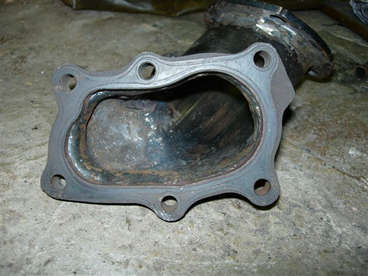
Figure 1. The turbo flange. Note the shape of the outlet. |
| d.
Once the 3 pipe was the correct size, I trimmed the 2 wastegate pipe
to size.
e. Cut a section out of the 3 pipe where the 2 pipe joins up. f. Tack it together with the welder and test fit again.
g. Weld it up. Note: if you are reusing
the cast iron flange, you either need to have the right equipment and skills
h. Weld in the oxygen sensor fitting.
i. Smooth off the insides,
be especially careful to remove any loose weld splatter and burs.
|
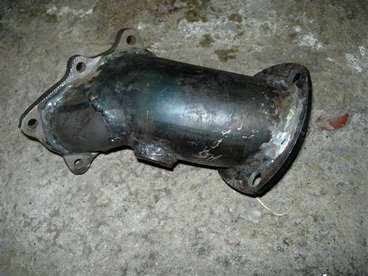
Figure 2. The completed dump pipe. |
| 5.
Take your existing oil line to Pirtek (or similar) and get them to make
up a copy with the correct fitting to attach to the new
turbo. 6.
The R33 turbo is water cooled, unlike the original, so you need to run
new water lines. I T-ed into the water pipes going to
a. I used 3/8 rubber heater
hose for the water supply. The throttle body pipes are 1/2", so I; used
1/2" tee
b. The turbo has 18 mm banjo fittings for
the water. I got some fittings from Pirtek, and got them to crimp them
|
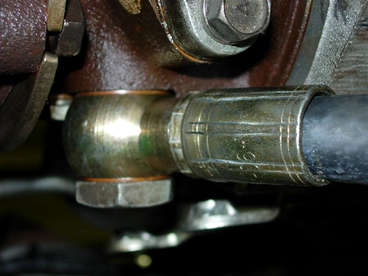
Figure 3. One of the crimp-on banjo fittings for the water line. |
| 7.
The compressor outlet of the R33 turbo is larger than the FJ 20 and exits
the turbo at a different angle, so some new intake
piping is needed. I took the opportunity to replace most of my piping to and from the intercooler.
a. The turbo outlet is ~65 mm, but
the remainder of my piping is 2. I used a rubber PVC pipe joiner to connect
b. From the joiner I ran a length of 2.25
exhaust pipe.
|
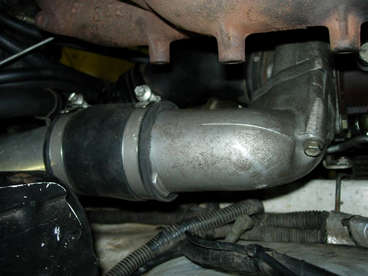
Figure 4. The turbo compressor outlet with the rubber joiner attached. |
| c.
I then flared the end of a piece of 2 pipe out to approx 2.25 and welded
it onto the 2.25 pipe. From this
point on the remainder of the piping is 2
d. For the bends in the intake I used 2
mandrel bent exhaust pipe. For flexible joins I reused the rubber hose
8.
Connect everything up to the turbo. Before connecting anything, make sure
that all pipes are clean, and dont have any
a. The original oil return pipe fits unmodified b. The original air intake pipe fits unmodified c. Fit the new water, oil inlet and compressor outlet piping. d. Fit the new dump pipe. You should use gasket goo, or even better a gasket.
e. Install the oxygen sensor.
|
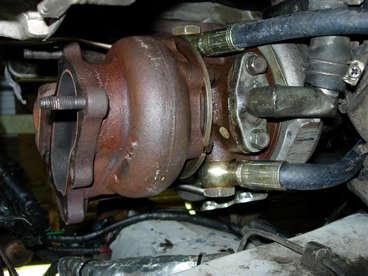
|
| 9.
Check water and oil levels.
10. Disconnect the
high tension lead from the coil and turn the engine over using the starter
motor to give the oil a chance to
11. Start it up. Check for: a. Oil and water leaks
b. That the water and oil pipe are getting
warm (an indication that fluid is flowing).
|
| Parts list |
| R33 Skyline turbocharger
$250
Exhaust shop parts, total $100 Mild steel exhaust pipe: 1 x 3 90 deg mandrel bend 2 x 2 45 deg mandrel bend 1 x 2 90 deg mandrel bend 1 m 2 straight pipe 1 x 2 90 deg press bend 200 mm 2.25 straight pipe 1 x 3 mild steel exhaust flange 1 x
Oxygen sensor weld-in fitting
Auto parts shop, total $40 2 m 3/8 heater hose 2 x 1/2" plastic T pieces 2 x 1/2" to 3/8 plastic reducers
Lots of hose clamps
Pirtek, total $25 2 x 18mm ID banjo fittings, crimp on 1 x Oil line made up, steel piping similar to standard pipe, ~12 mm? banjo fittings Bunnings, total $12 1 x Rubber pipe joiner, ~60 mm ID (for joining PVC pipe)
|
| More Pics |
The standard FJ20 turbo.
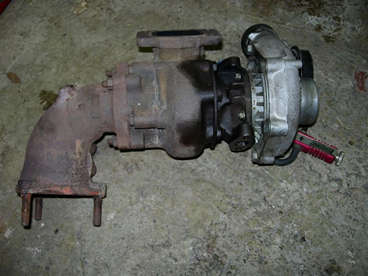
R33 Skyline turbo
|
|
|
|
|
|
|

-Thanks to Tim for this valuable info.